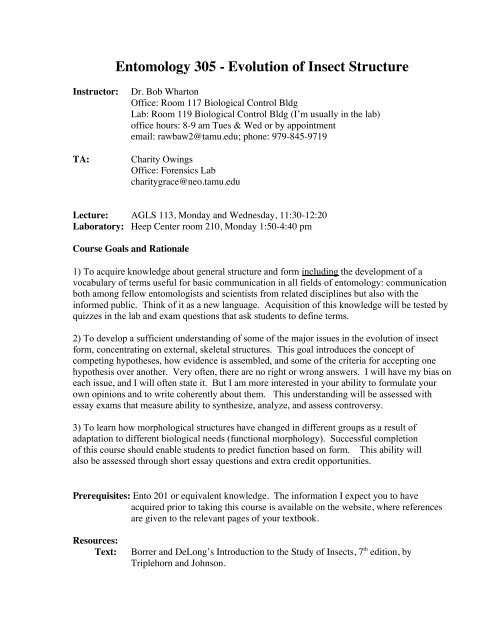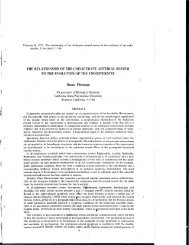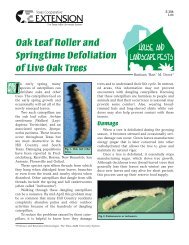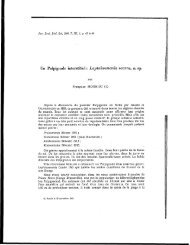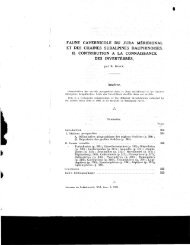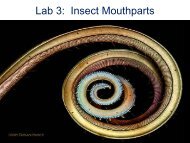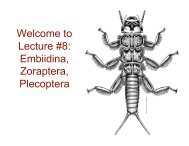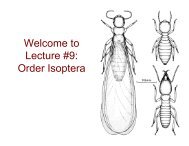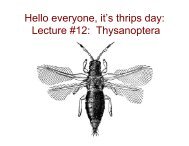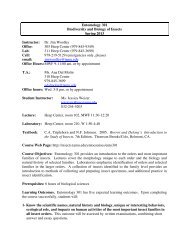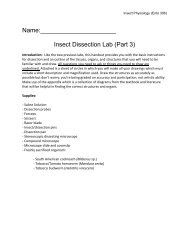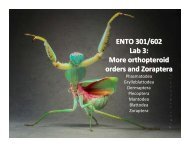Entomology 305 - Evolution of Insect Structure - Department of ...
Entomology 305 - Evolution of Insect Structure - Department of ...
Entomology 305 - Evolution of Insect Structure - Department of ...
You also want an ePaper? Increase the reach of your titles
YUMPU automatically turns print PDFs into web optimized ePapers that Google loves.
<strong>Entomology</strong> <strong>305</strong> - <strong>Evolution</strong> <strong>of</strong> <strong>Insect</strong> <strong>Structure</strong><br />
Instructor: Dr. Bob Wharton<br />
Office: Room 117 Biological Control Bldg<br />
Lab: Room 119 Biological Control Bldg (I’m usually in the lab)<br />
<strong>of</strong>fice hours: 8-9 am Tues & Wed or by appointment<br />
email: rawbaw2@tamu.edu; phone: 979-845-9719<br />
TA: Charity Owings<br />
Office: Forensics Lab<br />
charitygrace@neo.tamu.edu<br />
Lecture: AGLS 113, Monday and Wednesday, 11:30-12:20<br />
Laboratory: Heep Center room 210, Monday 1:50-4:40 pm<br />
Course Goals and Rationale<br />
1) To acquire knowledge about general structure and form including the development <strong>of</strong> a<br />
vocabulary <strong>of</strong> terms useful for basic communication in all fields <strong>of</strong> entomology: communication<br />
both among fellow entomologists and scientists from related disciplines but also with the<br />
informed public. Think <strong>of</strong> it as a new language. Acquisition <strong>of</strong> this knowledge will be tested by<br />
quizzes in the lab and exam questions that ask students to define terms.<br />
2) To develop a sufficient understanding <strong>of</strong> some <strong>of</strong> the major issues in the evolution <strong>of</strong> insect<br />
form, concentrating on external, skeletal structures. This goal introduces the concept <strong>of</strong><br />
competing hypotheses, how evidence is assembled, and some <strong>of</strong> the criteria for accepting one<br />
hypothesis over another. Very <strong>of</strong>ten, there are no right or wrong answers. I will have my bias on<br />
each issue, and I will <strong>of</strong>ten state it. But I am more interested in your ability to formulate your<br />
own opinions and to write coherently about them. This understanding will be assessed with<br />
essay exams that measure ability to synthesize, analyze, and assess controversy.<br />
3) To learn how morphological structures have changed in different groups as a result <strong>of</strong><br />
adaptation to different biological needs (functional morphology). Successful completion<br />
<strong>of</strong> this course should enable students to predict function based on form. This ability will<br />
also be assessed through short essay questions and extra credit opportunities.<br />
Prerequisites: Ento 201 or equivalent knowledge. The information I expect you to have<br />
acquired prior to taking this course is available on the website, where references<br />
are given to the relevant pages <strong>of</strong> your textbook.<br />
Resources:<br />
Text: Borrer and DeLong’s Introduction to the Study <strong>of</strong> <strong>Insect</strong>s, 7 th edition, by<br />
Triplehorn and Johnson.
Lab Manual: The lab manual must be purchased from a copy center <strong>of</strong>f campus; you will<br />
need it for the first lab and each subsequent lab.<br />
Supplemental material: Additional readings, including all those referenced in the<br />
outline on the webpage, will be available through the Evans Library ereserve system. Go<br />
to http://library-reserves.tamu.edu and follow instructions from there. I also have<br />
copies in my <strong>of</strong>fice and you can examine the real thing there.<br />
Class Web Page: http://insects.tamu.edu/students/undergrad/ento<strong>305</strong>. The web page<br />
contains information on prerequisites, a general outline for the course, references<br />
for supplemental reading for each topic covered in the lecture, examples <strong>of</strong> exam<br />
questions, some helpful hints for passing this course, and copies <strong>of</strong> most <strong>of</strong> the<br />
figures used in the powerpoint presentations. Lecture notes will not be made<br />
available.<br />
Extra Credit: See Lab Syllabus.<br />
Class Day Topic<br />
Class Schedule: Fall, 2011<br />
Monday, 29 August Course procedures and objectives. History <strong>of</strong> insect morphology.<br />
Importance <strong>of</strong> an evolutionary approach.<br />
Monday, 29 August Lab 1. General external anatomy.<br />
Wednesday, 31 August <strong>Evolution</strong>ary concepts and terms <strong>of</strong> location and direction.<br />
Monday, 5 September <strong>Structure</strong> and function <strong>of</strong> the insect integument.<br />
Monday, 5 September Lab 2. The insect head (quiz day)<br />
Wednesday, 7 September <strong>Evolution</strong> <strong>of</strong> the insect head.<br />
Monday, 12 September The cranium.<br />
Monday, 12 September Lab 3. <strong>Insect</strong> mouthparts (quiz day)<br />
Wednesday, 14 September Mouthparts.<br />
Monday, 19 September Mouthparts.<br />
Monday, 19 September Lab 4. <strong>Insect</strong> mouthparts (quiz day)<br />
Wednesday, 21 September Mouthparts.<br />
Monday, 26 September Antennae; QUIZ IN LECTURE<br />
Monday, 26 September Lab 5. <strong>Insect</strong> thorax – the tergum (quiz day)
Wednesday, 28 September Primary and Secondary Segmentation, <strong>Insect</strong> Thorax<br />
Monday, 3 October Thorax – the tergum and pleuron<br />
Monday, 3 October Lab 6. <strong>Insect</strong> thorax – the pleuron and sternum (quiz day)<br />
Wednesday, 5 October Thorax – the pleuron (continued) and sternum<br />
Monday, 10 October Legs; Review<br />
Monday, 10 October First Lab Exam<br />
Wednesday, 12 October First Lecture Exam (through lecture <strong>of</strong> Oct. 6)<br />
Monday, 17 October Musculature; Wings<br />
Monday, 17 October Lab 7. Musculature<br />
Wednesday, 19 October more wings<br />
Monday, 24 October Wings (continued)<br />
Monday, 24 October Lab 8. <strong>Insect</strong> thorax – Legs and wings (quiz day)<br />
Wednesday, 26 October Wings (conclusion)<br />
Monday, 31 October Wings and wing venation<br />
Monday, 31 October Lab 9. <strong>Insect</strong> Thorax – Wing venation (quiz day)<br />
Wednesday, 2 November The insect abdomen<br />
Monday, 7 November Abdomen – female genitalia<br />
Monday, 7 November Lab 10. <strong>Insect</strong> Abdomen (quiz day)<br />
Wednesday, 9 November Abdomen – male genitalia<br />
Monday, 14 November Review (ESA Meeting); classification <strong>of</strong> arthropods<br />
Monday, 14 November Lab 11. Abdominal appendages and genitalia (quiz day)<br />
Wednesday, 16 November Second Lecture Exam (ESA Meeting).<br />
Monday, 21 November Relationships <strong>of</strong> and among arthropods.<br />
Monday, 21 November LAB 12. The arthropods.<br />
Wednesday, 23 November Burgess Shale.<br />
Monday, 28 November Non-<strong>Insect</strong> Arthropods.<br />
Monday, 28 November Final Lab Exam.
Wednesday, 30 November Molting; development; immatures.<br />
Monday, 5 December Redefined day (= Friday)---therefore no class.<br />
Wednesday, 7 December Optional: Discussion and Review (Reading Day, no formal class).<br />
Final Examination: Monday, December 12, 10:30-12:30 pm<br />
Please Note:<br />
All exams (lecture and lab) will be comprehensive, that is, they will contain material<br />
covered on previous exams. Brief quizzes will be given at the beginning <strong>of</strong> the indicated<br />
lab periods.<br />
Course Grading<br />
Lecture Quiz 30 points<br />
Lecture Exam 1 100 points<br />
Lecture Exam 2 100 points<br />
Final Lecture Exam 150 points<br />
Lab Quizzes 45 points<br />
Lab Exam 1 75 points<br />
Final Lab Exam 100 points<br />
Total 600 points<br />
The grading scale is as follows:<br />
540 and above = A<br />
480-539 = B<br />
420-479 = C<br />
360-419 = D<br />
below 360 = F<br />
Rules <strong>of</strong> conduct for and during exams and quizzes:<br />
• There will be no excused trips to the bathroom or other excursions from the classroom during an<br />
exam.<br />
• If one must leave the room during an exam, that student’s exam must be terminated and submitted<br />
to the instructor. Exceptions to this rule will be made on a case-by-case determination at the<br />
discretion <strong>of</strong> the instructor in charge.<br />
• Examinations missed during an absence will be made up at the discretion <strong>of</strong> the instructor and<br />
only if the absence meets the guidelines <strong>of</strong> an <strong>of</strong>ficial absence. In general make up examinations
are discouraged.<br />
• All materials (books, papers, backpacks, electronic devices) are to be placed below the desk or in<br />
the front <strong>of</strong> the room and remain on the floor until the test has been terminated for all students.<br />
• Talking or looking at others while taking the test will be considered cheating and grounds for<br />
invoking academic dishonesty.<br />
• No food or drinks will be permitted during an examination.<br />
Attendance and class etiquette:<br />
Lecture attendance: Texas A&M University expects all students to attend class and<br />
to complete all assignments. Attendance does matter in this course, especially when it<br />
comes to assessing final grades for borderline cases. Points will be deducted for<br />
repeated, unexcused absences. For <strong>of</strong>ficial rules on attendance, please visit the<br />
student rules website (see http://student-rules.tamu.edu/rule07).<br />
Exams and quizzes: you will be required to take all quizzes and exams the days they<br />
are scheduled. Only the following absences are considered excused by Texas A&M<br />
Universiy:<br />
• Participation in an activity appearing on the university authorized activity list (see<br />
http://studentactivities.tamu.edu/online/sponsauth/).<br />
• Death or major illness in a student’s immediate family. Immediate family may include: mother,<br />
father, sister, brother, grandparents, spouse, child, spouse’s child, spouse’s parents, spouse’s<br />
grandparents, stepmother, step-father, step-sister, step-brother, step-grandparents, grandchild,<br />
step-grandchild, legal guardian, and others as deemed appropriate by faculty member or student’s<br />
academic dean.<br />
• Illness <strong>of</strong> a dependent family member.<br />
• Participation in legal proceedings or administrative procedures that require a student’s presence.<br />
• Religious holy day (see http://student-rules.tamu.edu/append4).<br />
• Illness that is too severe or contagious for the student to attend class (to be determined by Health<br />
Center or <strong>of</strong>f-campus physician). I require a note from the health care provider in such cases.<br />
• Required participation in military duties.<br />
• Mandatory admission interviews for pr<strong>of</strong>essional or graduate school, which cannot be<br />
rescheduled.<br />
Excused absences: Rules concerning excused absences may be found at http://studentrules.tamu.edu/rule07.<br />
In particular, except for absences due to religious obligations, the student<br />
must notify his or her instructor in writing (acknowledged e-mail message is acceptable) prior to<br />
the date <strong>of</strong> absence if such notification is feasible. In cases where advance notification is not<br />
feasible (e.g., accident, or emergency) the student must provide notification by the end <strong>of</strong> the<br />
second working day after the absence. This notification should include an explanation <strong>of</strong> why<br />
notice could not be sent prior to the class. If the absence is excused, the instructor must either<br />
provide the student with an opportunity to make up any quiz, exam or other graded activities or<br />
provide a satisfactory alternative to be completed within 30 calendar days from the last day <strong>of</strong> the<br />
absence.
Class etiquette:<br />
• Students are expected to be in their seats and prepared for lecture at the time scheduled for the<br />
start <strong>of</strong> class. Personal conversations should cease at this time.<br />
• If a student must be late, please enter quietly and be seated as close to the door as possible.<br />
• If you have reason to be late consistently, please discuss the reasons with the instructor and obtain<br />
approval.<br />
• If a student is absent, the student remains responsible for all lecture or laboratory subjects<br />
discussed and materials provided during the period(s) <strong>of</strong> absence.<br />
• No cell phones or pagers in use or active.<br />
Laboratory Safety<br />
The <strong>Department</strong> <strong>of</strong> <strong>Entomology</strong> is committed to the safety <strong>of</strong> all students and employees<br />
participating in teaching laboratories. To ensure that a safe environment is maintained in<br />
our teaching laboratories, it is expected that all students will adhere to general safety<br />
guidelines and emergency procedures, as well as course-specific and activity-specific<br />
safety instructions provided by faculty and teaching assistants. Laboratory safety and<br />
emergency procedures will be reviewed during the first class period and on a regular<br />
basis thereafter.<br />
Americans With Disabilities Act<br />
The Americans with Disabilities Act (ADA) is a federal anti-discrimination statute that<br />
provides comprehensive civil rights protection for persons with disabilities. Among other<br />
things, this legislation requires that all students with disabilities be guaranteed a learning<br />
environment that provides for reasonable accommodation <strong>of</strong> their disabilities. If a<br />
student believes he or she has a disability requiring an accommodation, he or she should<br />
contact the <strong>Department</strong> <strong>of</strong> Disabilities services, Cain Hall, Room B118 (979-845-1637)<br />
so that such accommodation can be made.<br />
Copyright, Honor Code, and Plagiarism<br />
The handouts used in this course are copyrighted. By “handouts” I mean all materials<br />
generated for this class, which include but are not limited to syllabi, quizzes, exams, lab<br />
manual, in-class materials, review sheets and additional problem sets. Because these<br />
materials are copyrighted, you do not have the right to copy the handouts, unless I<br />
expressly grant permission.<br />
The Honor Code: “An aggie does not lie, cheat, or steal or tolerate those who do.” Honor<br />
Council Rules and Procedures can be found at http://www.tamu.edu/aggiehonor<br />
As commonly defined, plagiarism consists <strong>of</strong> passing <strong>of</strong>f as one’s own the ideas, words,<br />
writings etc. which belong to another person. In accordance with this definition, you are<br />
committing plagiarism if you copy the work <strong>of</strong> another person and turn it in as your own,<br />
even if you should have the permission <strong>of</strong> that person. Plagiarism is one <strong>of</strong> the worst
academic sins, for the plagiarists destroys the trust among colleagues without which<br />
research cannot be safely communicated. If you have any questions regarding<br />
plagiarism, please consult the latest issue <strong>of</strong> the Texas A&M University Student Rules,<br />
under the section “Scholastic Dishonesty”.


